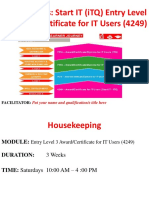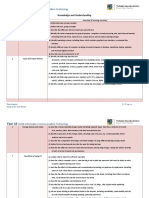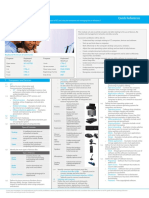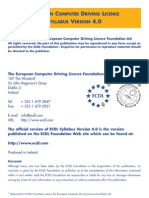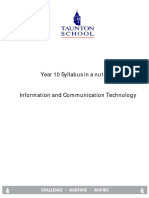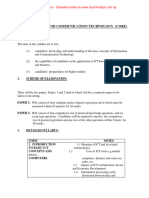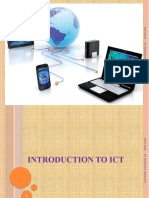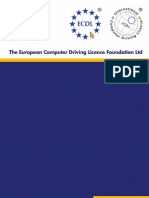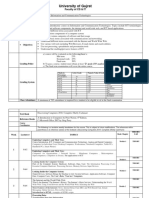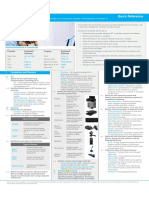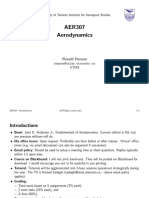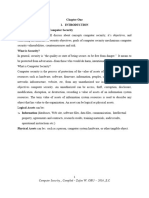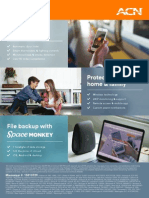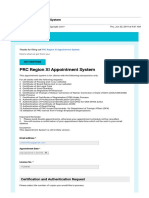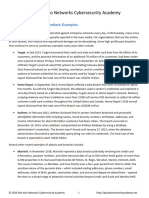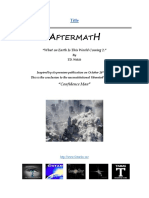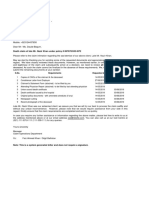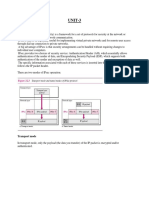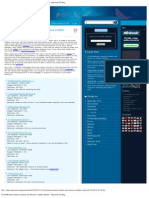Mapping grid
Learning Outcome (LO) LO1: Know about different types of ICT systems and be able to give examples of where and how they are used Content Types of ICT systems: PCs, laptops and other portable devices, main frame and super computers, embedded computers, games consoles Uses: retail, banking, administration, manufacturing, education, entertainment, communication, number crunching, simulations, modelling, stock control, logistics Hardware Input devices: keyboard, mouse, tracker ball, joystick, graphics tablet, scanner, digital camera, webcam, microphone, touch screen, OMR, OCR, bar code scanner, biometric scanner, magnetic stripe reader, chip and pin, sensors Processing: processor, memory, ROM, RAM Storage: hard disks, optical discs, flash memory, magnetic tape Output devices: monitor, printer, plotter, data projector, speakers, control devices Software Systems software: operating system, system software tools Applications software: office productivity tools, web authoring, image and sound editing, presentation software, control software, project management software LO3: Understand data storage capacity terminology Storage capacity terms: bit, byte and multiples of these (kbytes, mbytes, gbytes, tbytes) Chapter 2, p.2531 Chapter 2 defines these terms and uses them to describe the capacity of backing storage devices, such as hard disks on p.26, DVDs on p.28 and memory cards on p.31. Most of LO4 is covered in Chapters 1, 2 and 3. User needs are also considered throughout Chapter 12 where appropriate, e.g. p.259. Chapter 1, p.1 25 Chapter 2, p.2633 Chapter 3, p.3452 Student Book page(s) Chapter 1, p.1 25 Chapter 12, p.249290 Notes Chapter 1 is a general introduction to the hardware available and Chapter 12 looks at the uses of ICT systems.
LO4: Be able to select appropriate ICT systems to meet specified needs
User needs: for example business, entertainment, education, communication Hardware: type/speed of processor, amount of memory, capacity of hard drive, external storage devices, type of monitor, type of printer, additional requirements, for example graphics card, sound card Software: operating system, applications software Settings: window size, mouse settings, icon size, screen resolution, desktop contrast, sound volume
Chapter 1, p.3 Chapter 2, p.26, p.28 and p.31 Chapter 3, p.39, p.42
Edexcel IGCSE ICT
1
LO2: Understand that an ICT system is made up of hardware and software
Chapter 3 is a general introduction to the wide variety of software available, including operating systems. There is more detail about specific applications software throughout the book. For example, Chapter 10 covers web authoring in detail.
�Learning Outcome (LO)
Content
Student Book page(s)
Notes
Other considerations: range of facilities, versatility, speed of transmission, compatibility, performance LO5: Understand that ICT devices can be linked together to form networks Networks: wired, wireless; LAN, WAN Network components: cable, router, booster, wireless enabled devices (for example wi-fi, Bluetooth), media streaming devices IP address Chapter 9, p.175211 LO5 is covered in Chapter 9 and there are references to specific features of networks where appropriate throughout the book. For example, on p.18, and in Chapter 12. The advantages and disadvantages of networks are covered throughout the chapter where appropriate. For example, the advantages and disadvantages of LANs are covered on p.175 and of online shopping on p.195. P.263 is related to LO7 and covers computer crime, and physical and software security. Individual responsibility is covered. Chapter 10 has many references to the uses of browsers. For example, p.213 describes how to open a web page in a browser. Chapter 10 refers to many of the concepts developed elsewhere. P.48 covers software licensing.
LO6: Understand the benefits of establishing a network
Benefits: shared peripherals, shared data, flexible access, media streaming, communication, control of user access rights, centralised administration, simultaneous access to the Internet
Chapter 9, p.175211
Edexcel IGCSE ICT
LO7: Understand how data can be secured on a network
Network security: log-ins and passwords, firewall, WEP/WPA, encryption, file access rights, transaction logs, backups
Chapter 9, p.203 Chapter 2, p.29 Chapter 12, p.286
LO8: Understand requirements for connecting to the Internet
Hardware: modem, router, gateway, communication link Software: web browser, communication software Type of connection: broadband, dial-up, wi-fi, VPN
Chapter 9 p.177, p.179, p.181, p.182, p.189
LO9: Understand features of common internet services and be able to give examples of their use
Sources of services: Internet service provider (ISP) Services: worldwide web, email, news groups, forums, chatrooms, instant messaging, search engines, filter software Uses: e-commerce, advertising, news, education, entertainment, communication, socialising, customer support, software distribution
Chapter 9, p.181, p.190, p.197, p.198, p.184, p.203, p.205
LO10: Understand the facilities and services available on an intranet
Intranet: network of computers within a single organisation Facilities and services: company wide, notice boards, central repository for information such as staff directory, forms Impact on individuals Positive effects: flexible/mobile working,
Chapter 9, p.189
LO11: Understand the impact of ICT on
Chapter 12, p.279
The impact of ICT is noted throughout the
�Learning Outcome (LO) individuals, organisations and society
Content better access to information and services, new job opportunities, new skills requirements, new ways of learning, wider range of entertainment and leisure opportunities Negative effects: potential job losses, less social interaction, reduced physical activity Impact on organisations: improved communication, access to global markets, changes in the way information is managed and used, security issues Impact on society: social and moral effects of unrestricted Internet access, widening gap between information rich and information poor
Student Book page(s) book.
Notes
Chapter 9, p.203 Chapter 3, p.48
LO13: Know about legal constraints on the use of information
Constraints: use of personal data, music downloads, acknowledgement of sources, avoiding plagiarism, getting permission
Chapter 12, p.277, p.282, p.287 Chapter 9, p.184, p.201
LO14: Be able to select and use interface features and system facilities effectively to meet needs
Interface features: desktop, windows, dialogue box, menu, sub-menu, toolbar, scrollbar, drag and drop, zoom, minimise, maximise System facilities: template, wizard
Chapter 3, p.41 introduces GUIs and there are numerous examples of the relevant interface and system facilities throughout Chapters 38 and 10. Chapters 3, p.3452, Chapter 4, p.5386 Chapter 12, p.281
There are numerous examples of dialogue boxes: p.152 refers to the edit colours dialogue box in Paint, and p.97 refers to the format cells dialogue box in Excel. P.71 covers the use of templates in word processing. While Chapters 3 and 4 cover LO15, there are numerous examples throughout Chapters 5 8 and 10. This LO is addressed where appropriate throughout the book.
LO15: Be able to manage files and folder structures to enable efficient information retrieval LO16: Understand the need to create a safe working environment
Files: create, open, save, save as, print, close, delete, view, move/copy, name appropriately Folders: create folders and sub-folders, name appropriately Health issues: ergonomic furniture, adjustable seating, appropriate lighting, taking breaks, wrist rests and other devices Safety issues: arrangement of hardware and cables, avoid hazards Risks: accidental deletion, deliberate damage such as viruses, unauthorised access
LO17: Understand potential risks to data and personal information
Chapter 12, p.283 Chapter 9, p.203
This LO is addressed where appropriate throughout the book.
Edexcel IGCSE ICT
3
LO12: Understand legal issues relating to use/misuse of ICT and the constraints placed on individuals
Legal issues: data protection, computer crime, fraud, copyright
Chapter 12, p.282
P.287 is related to LO12 and covers individual responsibility.
�Learning Outcome (LO) LO18: Understand methods available to secure data and personal information
Content
Student Book page(s) Chapter 2, p.29 Chapter 12, p.249, p.260, p.283, p.286 Chapter 9, p.176, p.190, p.203, p.205 Chapter 12, p.287 Chapter 9, p.201
Notes
Data security: create backups, keep copies safe, keep password/PIN secret, regularly change password Virus protection: use virus-checking software, treat files from unknown sources with caution Prevention of unauthorised access: firewalls, encryption, adware, spyware
This LO is addressed where appropriate throughout the book.
LO19: Understand the need to stay safe and respect others when using ICTbased communication LO20: Be able to select and use appropriate sources of ICT-based and other forms of information which match requirements LO21: Be able to select information that matches requirements from a variety of sources and evaluate fitness for purpose LO22: Be able to use appropriate search techniques and queries to locate and select relevant information
Staying safe: avoid inappropriate disclosure of personal information/disclosure to unauthenticated sources, avoid misuse of images, use appropriate language, respect confidentiality, use copy lists with discrimination, use social networking sites with caution ICT-based: CDs, DVDs, text messages, podcasts, web logs, web-based reference sites Others: newspapers, books, images, maps, conversations
This LO is addressed where appropriate throughout the book.
Edexcel IGCSE ICT
Chapter 9, p.184, p.190, p.199
Exercise 9.3 addresses this LO and the answers to the questions are available on the website. P.27 describes the hardware features of CDs. This LO is addressed where appropriate throughout the book.
Fitness for purpose: recognise intention and authority of provider, currency of the information, relevance, bias
Chapter 9, p.203
Techniques: multiple search criteria, quotation marks, search within results, relational operators, logical operators, find or search tool including wildcards
Chapter 3, p.35 Chapter 4, p.60 Chapter 6, p.116, p.130 and throughout the chapter Chapter 9, p.187
This LO covers the use of search engines, searching a database, using find and replace and other search strategies and is referred to where appropriate throughout the book. Chapter 3 is an introduction to the more detailed ICT skills development in Chapters 48 and 10. LO24 is covered in Chapter 4. These are generic concepts used throughout Chapters 5 8 and 10. For example, a specialised use of tables, look-up tables, is referred to in Chapter 5.
LO23: Be able to select and use software applications to meet needs and solve problems LO24: Be able to enter, organise, develop, refine and format information, applying editing techniques to meet needs
Software applications: word processing, spreadsheet, database, graphics, web authoring, presentation, audio and video editing software Organise: structure of information, document layout, headings, sub-headings, lists, tables, use of templates Edit: highlight, drag and drop, find, replace, undo, redo, templates
Chapter 38, Chapter 10
Chapter 4, p.5386
�Learning Outcome (LO) LO25: Be able to use appropriate page layout
Content
Student Book page(s) Chapter 4, p.5386
Notes
Layout: columns, margins, header, footer, portrait, landscape, page breaks, page numbering
LO25 is covered in Chapter 4. These are generic concepts used throughout Chapters 58 and 10. For example, columns and rows are important basic concepts in spreadsheets in Chapter 5. LO26 is covered in Chapter 4. These are generic concepts used throughout Chapters 58 and 10.
LO27: Be able to obtain, insert, size, crop, alter and position images LO28: Be able to enter, format, develop and analyse numerical information
Images: clipart, photographs, scanned images, borders
Chapter 4, p.79
Data types: text, number Format: currency, %, number of decimal places, date, time, text wrap, row height, column width, gridlines, merged cells, cell borders Formulae: single operator, formulae with multiple operators, absolute and relative cell referencing Functions: SUM, AVG, IF THEN Additional features: linked tables, macros Graphs and charts: pie chart, bar chart, single line graph, scattergram, appropriate format, titles, axis labels, legends
Chapter 5, p.87114
LO28 is covered in Chapter 4. Many of these are generic concepts used throughout Chapters 68 and 10.
LO29: Be able to enter, organise and sort structured information
Data types: logical/Boolean, alphanumeric/text, numeric (real and integer), date Structure: record, field, table, primary key/key field, related tables Validation: range check, presence check, type check, length check Sort: single field, multiple fields, ascending/descending order Input: tables, forms Search: single criterion, multiple criteria, search within results, relational operators, logical operators Output: report, mail merge documents
Chapter 6, p.115149 Chapter 4, p.73
LO29 is covered in Chapter 6. There is more detail on mail merge on p.73.
Edexcel IGCSE ICT
5
LO26: Be able to enter and format text and tables to maximise clarity and enhance presentation
Format text: bullets, numbering, subnumbering, alignment, tabs, line spacing, colour, font, style, size, tables Format tables: horizontal and vertical text alignment, merge and split cells, gridlines, borders, shading
Chapter 4, p.5386
�Learning Outcome (LO) LO30: Be able to bring together and organise different types of information to achieve a purpose
Content Types of information: image, chart, text alignment, captions Organise: text wrap, use of text boxes, behind, in front, grouping, animation, slide transition Purpose: poster, newsletter, web page, leaflet, multi-media presentation
Student Book page(s) Chapter 8, p.165174 Chapter 4, p.79 Chapter 10, p.212228
Notes Many of the concepts of LO30 are generic and used throughout Chapters 48 and 10.
LO31: Be able to work accurately and proofread, using software facilities where appropriate for the task LO32: Be able to produce information that is fit for purpose and audience using accepted layouts and conventions as appropriate LO33: Know how to create, access, read and respond to email and other ICT-based communication LO34: Be able to evaluate the effectiveness of solutions
Software facilities: spellcheck, grammar check, print preview
Chapter 4, p.56, p.59
There is guidance on approaches to proofreading on p.59.
Edexcel IGCSE ICT
Layouts: letter, memo, report, newsletter, leaflet, poster, web page, information sheet, multimedia presentation Conventions: salutation, complimentary close on letters, page numbers, headers and footers on reports, columns, date, issue number on newsletters Email: open, read, reply, forward, to, cc, bcc, add and open attachments
Chapter 4, p.5386 Chapter 8, p.165174
Many of the concepts of LO32 are generic and used throughout Chapters 410.
Chapter 9, p.190
Many of the concepts of LO33 are generic and used throughout Chapters 410. For example, on p.158, Exercise 7.2, 3 n) pupils are asked to evaluate a movie they have created. P.208, Exercise 9.3 has comparative exercises.
Effectiveness: assessing fitness for purpose, suggesting improvements
LO34 is implicit throughout the book








